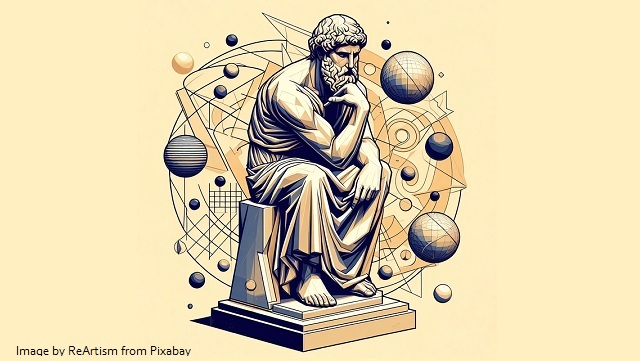It’s important to know the difference…
I had a nice chat the other day with a friend, and the subject came up: what is the difference between normal thinking and Critical Thinking? I thought we must have covered this before here, but I couldn’t find it. My apologies…
Briefly, Critical Thinking = normal thinking + more thoroughness + wisdom.
Critical Thinking is deeper and wider than normal thinking.
The word “critical” is key. It means thinking that is cautious, reflective, questioning, skeptical, …
A Good Analysis —
From this fine discussion: Thinking is a fundamental human activity, occurring when the mind processes information and forms ideas or concepts. It can be spontaneous, random, or directed, allowing us to understand, interpret, and make decisions about the world around us. Critical thinking, however, is a refined form of thinking. It demands a deeper level of analysis, evaluation, and synthesis of information to form a judgment.
Thinking can be passive. For instance, daydreaming or recalling a memory requires thinking but not necessarily any analytical process. Critical thinking, in contrast, is always active. It involves assessing the credibility of sources, identifying biases, and weighing evidence before drawing conclusions.
While thinking can often be based on personal beliefs, feelings, or incomplete information, Critical Thinking necessitates a rigorous approach to ensure objectivity and accuracy. It’s a skill that needs to be cultivated and practiced, requiring one to be skeptical, open-minded, and methodical.
Thinking is inherent and is something we do every day without much effort. Critical thinking, on the other hand, often requires more energy and attention. It challenges one’s own beliefs and assumptions, aiming for clarity, coherence, and logical consistency.
An Example —
From this college course: answer this question with the first answer that comes to mind, no matter what it is… A student went to the campus bookstore and bought two pencils for a total of 10 cents. How much did each pencil cost?
If you answered 5 cents (a total of 10 cents divided by two pencils equals 5 cents), your thinking fits the definition of normal thinking. In other words, it was based on simple recall of memorized information. You recalled those math formulas you memorized in school in order to answer the question.
On the other hand, if you had any other answer, you weren’t just thinking normally — you were likely thinking critically, because you were doing more than relying on recall of basic information.
For those in the latter case, unconsciously their thinking/ reasoning warning light went off. Perhaps they said to themselves, “I can’t tell. Maybe: a) one pencil is bigger than the other, or b) one is a red pencil, or c) one is a bigger pencil. In these cases, one pencil may cost 6 cents and the other 4 cents.”
Or perhaps you thought, “Wait a minute, I need more information.” Maybe you questioned the whole idea of two pencils being so cheap, or you thought that this had to be some type of trick question because it was so simple.
Hopefully, this simple example makes this distinction clearer…
Takeaway —
Put yet another way, regular thinking is like taking a drink of water — which most of us do reflexively a dozen or more times a day.
Critical Thinking is more like going to a winery and trying out several sample offerings. Both times we are swallowing liquids, but at the latter we are much more attentive — and critical!
Some sample good references:
- Critical Thinking College Course: University of Alabama
- Difference Between Thinking and Critical Thinking
- Critical Thinking vs. Thinking
- Critical Thinking and Non-Critical Thinking: Key Differences
- Thinking vs. Critical Thinking: What’s the Difference?
- Thinking vs Critical Thinking: Difference and Comparison
- Stanford Encyclopedia of Philosophy: Critical Thinking
- Three Types of Thinking and Why They’re All Important
©2025 John Droz, Jr. All rights reserved.
Here is other information from this scientist that you might find interesting:
I am now offering incentives for you to sign up new subscribers!
I also consider reader submissions on Critical Thinking on my topics of interest.
Check out the Archives of this Critical Thinking substack.
WiseEnergy.org: discusses the Science (or lack thereof) behind our energy options.
C19Science.info: covers the lack of genuine Science behind our COVID-19 policies.
Election-Integrity.info: multiple major reports on the election integrity issue.
Media Balance Newsletter: a free, twice-a-month newsletter that covers what the mainstream media does not do, on issues from COVID to climate, elections to education, renewables to religion, etc. Here are the Newsletter’s 2025 Archives. Please send me an email to get your free copy. When emailing me, please make sure to include your full name and the state where you live. (Of course, you can cancel the Media Balance Newsletter at any time – but why would you?
The post Thinking vs Critical Thinking appeared first on Dr. Rich Swier.
Click this link for the original source of this article.
Author: John Droz, Jr.
This content is courtesy of, and owned and copyrighted by, https://drrichswier.com and its author. This content is made available by use of the public RSS feed offered by the host site and is used for educational purposes only. If you are the author or represent the host site and would like this content removed now and in the future, please contact USSANews.com using the email address in the Contact page found in the website menu.








